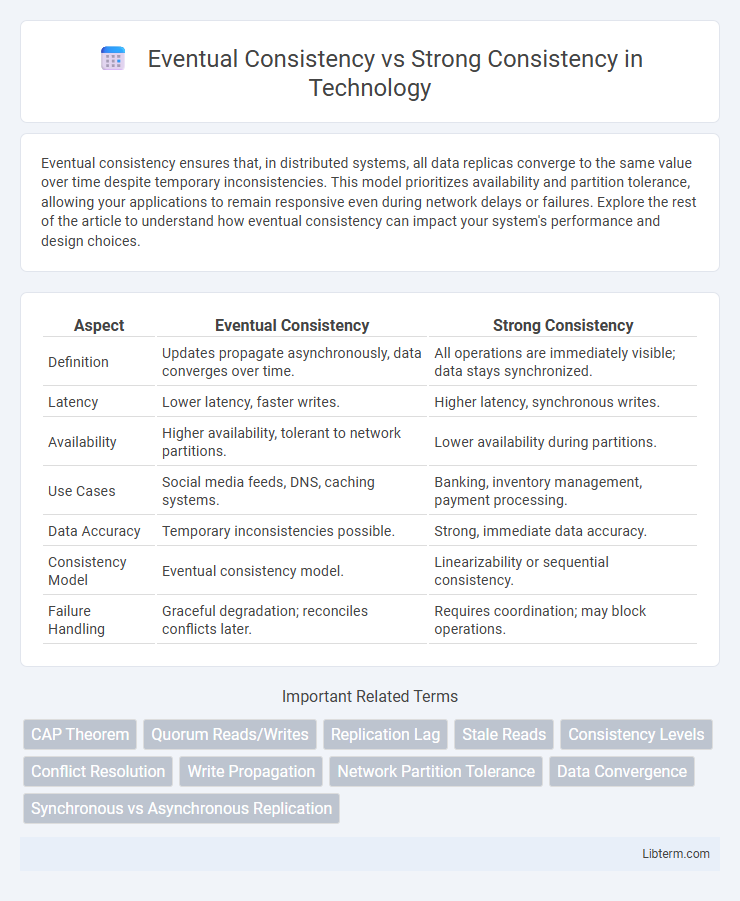Eventual consistency ensures that, in distributed systems, all data replicas converge to the same value over time despite temporary inconsistencies. This model prioritizes availability and partition tolerance, allowing your applications to remain responsive even during network delays or failures. Explore the rest of the article to understand how eventual consistency can impact your system's performance and design choices.
Table of Comparison
| Aspect | Eventual Consistency | Strong Consistency |
|---|---|---|
| Definition | Updates propagate asynchronously, data converges over time. | All operations are immediately visible; data stays synchronized. |
| Latency | Lower latency, faster writes. | Higher latency, synchronous writes. |
| Availability | Higher availability, tolerant to network partitions. | Lower availability during partitions. |
| Use Cases | Social media feeds, DNS, caching systems. | Banking, inventory management, payment processing. |
| Data Accuracy | Temporary inconsistencies possible. | Strong, immediate data accuracy. |
| Consistency Model | Eventual consistency model. | Linearizability or sequential consistency. |
| Failure Handling | Graceful degradation; reconciles conflicts later. | Requires coordination; may block operations. |
Understanding Data Consistency Models
Eventual consistency ensures that all replicas of data will converge to the same state over time, offering higher availability and partition tolerance in distributed systems. Strong consistency provides immediate synchronization across all replicas after a write operation, guaranteeing that any read reflects the most recent write. Understanding these data consistency models is crucial for designing systems that balance performance, fault tolerance, and user experience in distributed databases and cloud environments.
What is Strong Consistency?
Strong consistency ensures that any read operation after a write returns the most recent data, maintaining a single, up-to-date view of the system across all nodes. This model guarantees immediate synchronization of changes, preventing stale or conflicting data from being read. Strong consistency is critical in applications requiring real-time accuracy, such as financial transactions and inventory management systems.
What is Eventual Consistency?
Eventual consistency is a consistency model used in distributed systems where updates to a data item will propagate to all replicas eventually, ensuring all copies converge to the same value over time. It prioritizes availability and partition tolerance, allowing systems to continue operating despite network delays or failures, at the cost of temporary data inconsistency. Commonly implemented in NoSQL databases like Amazon DynamoDB and Apache Cassandra, eventual consistency enables high scalability and fault tolerance in large-scale applications.
Key Differences Between Eventual and Strong Consistency
Eventual consistency allows data updates to propagate asynchronously, meaning that all replicas will converge to the same value over time, but immediate consistency is not guaranteed. Strong consistency ensures that any read operation returns the most recent write, providing immediate synchronization across all data replicas. Key differences include latency, where eventual consistency favors lower latency and availability, while strong consistency prioritizes accuracy and immediate data correctness at the cost of higher latency.
Pros and Cons of Strong Consistency
Strong consistency ensures immediate data accuracy across distributed systems, providing reliable and predictable read operations critical for financial transactions and inventory management. The primary drawback lies in increased latency and reduced system availability during network partitions, as operations must be synchronized across nodes before confirmation. This strict consistency model can lead to performance bottlenecks in high-throughput environments where eventual consistency offers greater scalability.
Pros and Cons of Eventual Consistency
Eventual consistency offers improved system availability and scalability by allowing data updates to propagate asynchronously across distributed nodes, reducing latency and handling network partitions effectively. However, it may lead to temporary data conflicts and stale reads, which can complicate application logic and affect user experience in scenarios requiring immediate data accuracy. Choosing eventual consistency suits systems prioritizing high availability and partition tolerance over immediate consistency guarantees.
Use Cases for Strong Consistency
Strong consistency is essential in use cases requiring immediate and accurate data accuracy, such as financial transactions, inventory management, and user authentication. Systems like banking platforms, stock trading applications, and airline booking systems depend on strong consistency to prevent data anomalies, duplicate transactions, or resource overbooking. Enforcing strong consistency guarantees that all clients access the most recent and unified data state, critical for decision-making and regulatory compliance.
Use Cases for Eventual Consistency
Eventual consistency is ideal for distributed systems requiring high availability and low latency, such as social media platforms and e-commerce sites handling user-generated content or product catalog updates. Use cases include real-time messaging apps where slight delays in data synchronization are acceptable, and IoT networks where devices operate independently yet need to reconcile state changes eventually. This model supports scenarios prioritizing scalability and partition tolerance over immediate consistency, ensuring system responsiveness during network partitions.
Choosing the Right Consistency Model for Your Application
Choosing the right consistency model depends on application requirements for latency, availability, and data accuracy. Eventual consistency offers high availability and low latency by allowing temporary data discrepancies, making it ideal for distributed systems like social media or caching. Strong consistency ensures immediate data accuracy across nodes, suitable for scenarios demanding immediate accuracy such as financial transactions or inventory management.
Conclusion: Balancing Consistency and Performance
Achieving a balance between eventual consistency and strong consistency depends on the specific application's tolerance for latency and data accuracy. Systems prioritizing high availability and low latency often adopt eventual consistency, allowing temporary data discrepancies while ensuring overall performance. Conversely, applications requiring precise data integrity and immediate consistency must implement strong consistency mechanisms, accepting potential performance trade-offs.
Eventual Consistency Infographic

 libterm.com
libterm.com